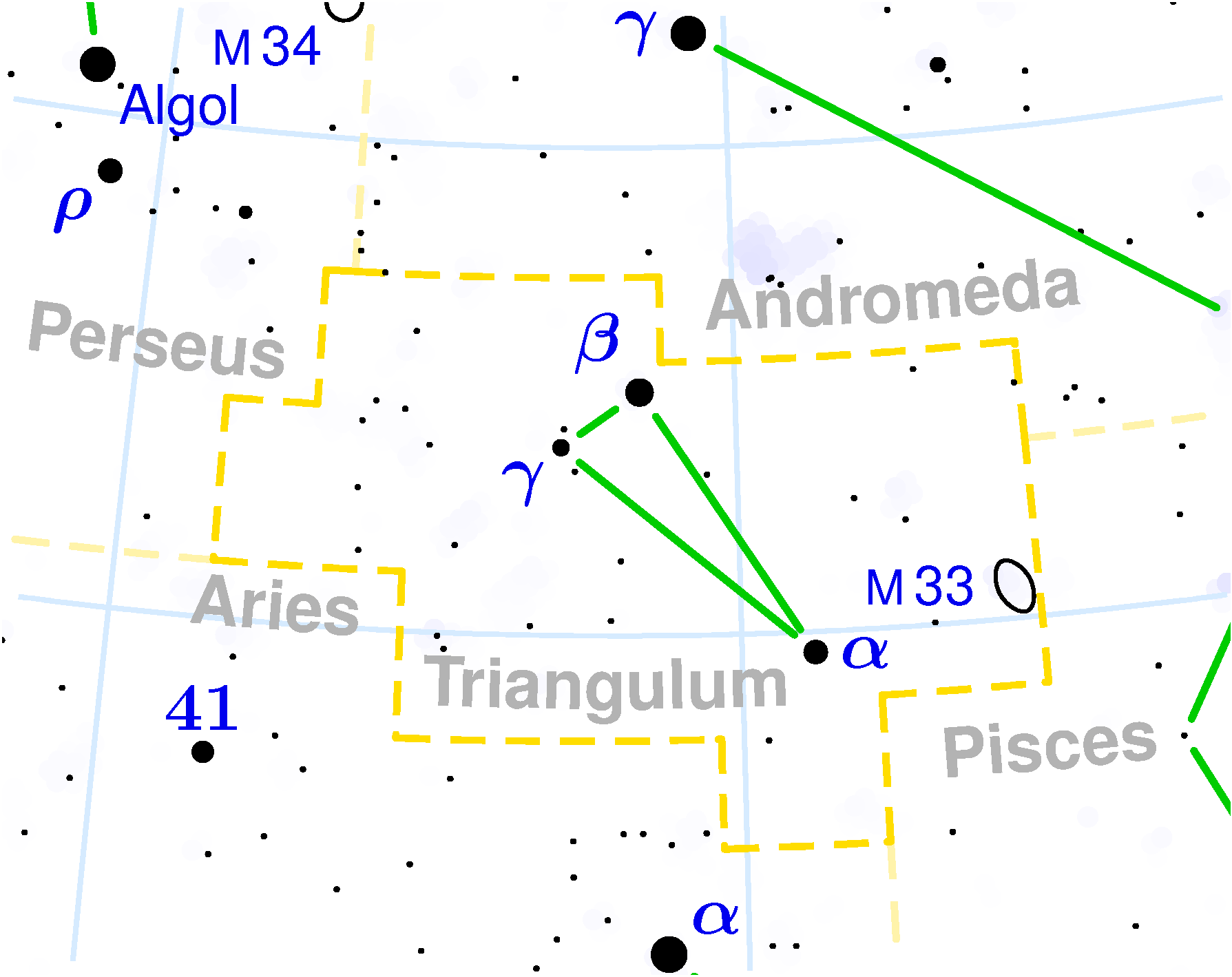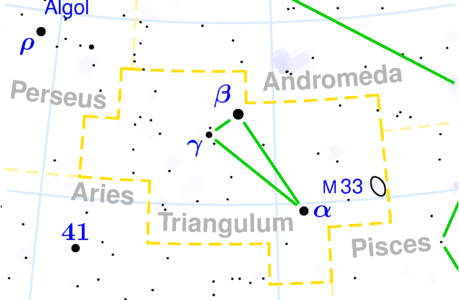The Triangulum constellation, also known as Triangulum Australe or the Southern Triangle, is a small but distinct group of stars located in the southern hemisphere. While not as well-known as some of the other constellations, Triangulum has a rich history and mythology associated with it, and it can be a rewarding sight for stargazers in Ireland who know when and where to look.
History and Mythology of Triangulum
Triangulum was first catalogued by the French astronomer Nicolas Louis de Lacaille in the 18th century. It is located near the southern celestial pole, which means it is visible in the southern hemisphere all year round, but only partially visible in the northern hemisphere. Triangulum is composed of three main stars arranged in the shape of a triangle, hence its name.
In ancient Greek mythology, the Triangulum constellation was said to represent the island of Delos, the birthplace of the god Apollo and his twin sister Artemis. According to the legend, the island was once adrift in the sea, but was anchored in place by Zeus as a favor to Leto, the mother of Apollo and Artemis. The three stars of Triangulum were said to represent the three points of the anchor that held Delos in place.
Viewing Triangulum from Ireland
If you’re in Ireland and want to view the Triangulum constellation, the best time to look is during the winter months, when the constellation is highest in the sky. Triangulum is located in the southern part of the sky, so you’ll need to find a spot with a clear view of the horizon to see it.
The easiest way to find Triangulum is to look for the constellation of Orion, which is visible in the winter months in the northern hemisphere. Orion’s belt points almost directly to Triangulum, making it easy to spot. Once you’ve located Orion, look for a faint triangle of stars below and to the left of the constellation. That’s Triangulum.
While Triangulum is not as bright or prominent as some of the other constellations, it can still be a rewarding sight for stargazers in Ireland who are looking for a challenge. Remember to find a dark location away from city lights, and to give your eyes time to adjust to the darkness. Using a telescope or binoculars can also help you see the stars more clearly.
Conclusion
The Triangulum constellation is a fascinating group of stars with a rich history and mythology. While not as well-known as some of the other constellations, it can be a rewarding sight for stargazers in Ireland who know when and where to look. By following these tips and finding a clear, dark location, you can experience the wonder of Triangulum and appreciate the beauty of the night sky.
How can I see the constellation of Triangulum from Ireland?
To see the Triangulum constellation from Ireland, you will need to wait until the winter months when it is highest in the sky. Triangulum is located in the southern part of the sky, so you will need to find a location with a clear view of the southern horizon.
The easiest way to find Triangulum is to first locate the constellation of Orion, which is visible in the winter months in the northern hemisphere. Orion’s belt points almost directly to Triangulum, making it easy to spot. Once you have located Orion, look for a faint triangle of stars below and to the left of the constellation. That’s Triangulum.
It’s important to find a dark location away from city lights to get the best view of the stars. Give your eyes time to adjust to the darkness and consider using binoculars or a telescope to help you see the stars more clearly.
Remember that weather conditions can also affect your ability to see stars, so choose a clear night with minimal cloud cover for the best viewing conditions. With a little patience and the right location, you should be able to spot the Triangulum constellation from Ireland.
The mythology of the constellation of Triangulum
In ancient Greek mythology, the Triangulum constellation, also known as Triangulum Australe or the Southern Triangle, was associated with the island of Delos, the birthplace of the god Apollo and his twin sister Artemis.
According to the myth, the island of Delos was once a floating island in the Aegean Sea, and it was the birthplace of the divine twins. The island’s mobility caused great distress to Leto, the mother of Apollo and Artemis, who was searching for a safe place to give birth. Leto prayed to Zeus, the king of the gods, to find a permanent place for Delos to anchor, and he agreed.
Zeus ordered Poseidon, the god of the sea, to bring the island to a fixed location in the Aegean Sea, where it became known as the birthplace of Apollo and Artemis. As a symbol of the island’s anchor, Zeus placed the three stars of Triangulum in the sky to represent the three points of the anchor that held Delos in place.
In another version of the myth, Triangulum represents the sails of the Argo, the legendary ship used by Jason and the Argonauts on their quest for the Golden Fleece.
The Triangulum constellation has also been associated with other myths and cultures throughout history, including the Australian Aboriginal people, who saw the three stars as the tail of the Kangaroo, and the indigenous people of South America, who believed the stars represented a bird.
Today, Triangulum remains a fascinating constellation with a rich history and mythology, and it continues to capture the imagination of stargazers and astronomers around the world.
The Stars in the constellation of Triangulum
The Triangulum constellation, also known as Triangulum Australe or the Southern Triangle, is a small constellation located in the southern hemisphere. It is composed of three main stars arranged in the shape of a triangle, which gives the constellation its name. The three stars of Triangulum are Alpha, Beta, and Gamma Trianguli, and they are all relatively faint compared to other prominent stars in the night sky.
Alpha Trianguli, also known as Mothallah, is the brightest star in the constellation and has a magnitude of 3.41. It is a yellow giant star located about 64 light-years away from Earth. Beta Trianguli, also known as Elmuthalleth, is the second-brightest star in the constellation and has a magnitude of 3.00. It is a blue-white main-sequence star located about 130 light-years away from Earth.
Gamma Trianguli, also known as Deltanna, is the third-brightest star in the constellation and has a magnitude of 4.00. It is a binary star system composed of two white dwarf stars located about 35 light-years away from Earth. The two stars orbit each other every 11.2 hours and are so close together that they are difficult to observe separately.
In addition to these three main stars, there are several other stars and deep-sky objects located in the Triangulum constellation, including several galaxies. One of the most notable is the Triangulum Galaxy, also known as Messier 33 or NGC 598, which is a spiral galaxy located about 2.7 million light-years away from Earth. The Triangulum Galaxy is one of the most distant objects visible to the naked eye and is a popular target for amateur astronomers.
Despite its small size and relatively faint stars, the Triangulum constellation remains an interesting and important part of the night sky. Its three main stars and numerous deep-sky objects offer a wealth of opportunities for observation and study, and they continue to fascinate and inspire astronomers and stargazers around the world.
Deep sky objects visible in the Constellation of Triangulum
The Triangulum constellation, also known as Triangulum Australe or the Southern Triangle, contains several deep-sky objects that are visible to amateur astronomers. These objects include galaxies, star clusters, and nebulae.
- Triangulum Galaxy (M33): The Triangulum Galaxy is a spiral galaxy located about 2.7 million light-years away from Earth. It is one of the most distant objects visible to the naked eye and is a popular target for amateur astronomers. The galaxy has a diameter of about 60,000 light-years and contains hundreds of billions of stars.
- NGC 6025 is an open star cluster located about 2,100 light-years away from Earth. The cluster contains several young, hot stars and is easily visible through a small telescope.
- NGC 6027 is another open star cluster located about 2,600 light-years away from Earth. It contains several dozen stars and is also easily visible through a small telescope.
- IC 469 is a small planetary nebula located about 6,000 light-years away from Earth. It is a faint object and requires a larger telescope to observe.
- NGC 5979 is a barred spiral galaxy located about 160 million light-years away from Earth. It has a bright core and is visible through a medium-sized telescope.
- NGC 5949 is a lenticular galaxy located about 63 million light-years away from Earth. It has a bright core and is visible through a medium-sized telescope.
- NGC 6028 is a spiral galaxy located about 97 million light-years away from Earth. It is a faint object and requires a larger telescope to observe.
The Triangulum constellation is not as well-known as some of the other constellations, but it contains several interesting and unique deep-sky objects that are worth exploring. With a small telescope, amateur astronomers can observe these objects and gain a deeper understanding of the universe around us.

